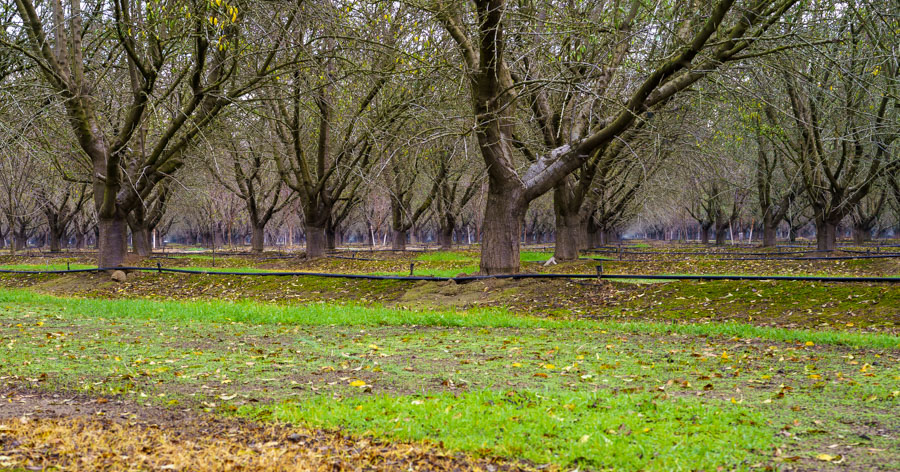If you are an almond grower, I am sure you have heard the term “chill hours”. In this blog post, I will explain in more detail what chill hours are, how they affect almond production. And give you some suggestions on how to track chill hours using different models.
First let’s answer the question: what are the almond chill hours?
Chill hours are a measure of the amount of chilly weather that permanent crops, such as almonds, need to break buds in the late winter or spring. Think of it as two step evolution: chilling is the first step, and the heat accumulation is the second. Bud break is the finish line. The length of each step depends on the crop and variety. The weather during evolution influences the speed. Good chilling weather speeds up the chilling step, warmer weather can slow it down or even stop it. Cool weather on the warming step slows the progress towards bloom.
Chill hours are critical because they affect the timing and duration of bloom, which is the most critical time in an almond crop season. Less chill hours can lead to an extended bloom. Too little can result in permanent bud damage. ‘Good chilling’ (more chilling than the minimum required) can produce a noticeably short bloom season, or ‘snowball bloom’. Chilling models can provide almond growers and their advisors with key information to time dormancy-breaking materials (hydrogen cyanamide, oil, etc.) to influence bloom to improve or maintain yield and quality in areas where orchard chilling is marginal.
How many chill hours do almonds need?
The chilling requirement for almonds is 200-300 hours. This means that almonds need at least 200-300 hours of temperatures below 45 degrees Fahrenheit (7.2 Celsius) from Nov. 1 to Jan. 15 to break bud properly. However, different almond varieties may have slightly different chilling requirements. For example, some sources suggest that Nonpareil almonds need more chill hours (400-600). Therefore, it is important to know the specific chilling requirement of your almond variety before planting or managing your orchard.

How to track chill hours using different models?
There are different models to track chill hours for almonds. The most common ones are:
- The Chill Hours Model: This model counts any hour between 32°-45° F (0°-7.2° C) as the same. It is simple and easy to use, but it does not account for the variation in chill value at different temperatures or the negative effects of warm temperatures on chilling accumulation.
- The Chill Portions Model (also called the Dynamic Model): This model gives different chill values to different temperature ranges. No more wondering about the value of ‘warm’ chill hours. Temperatures between 43°-47° F (6°-8° C) have the most chill value. The chill value on either side of that range is lower, dropping to no value at 32° F (0° C) and 54° F (12° C). This model also accounts for the negative effects of warm temperatures on chilling accumulation by subtracting chill portions when temperatures exceed 54° F (12° C).
- The Utah Model: This model is like the Chill Portions Model, but it uses a different temperature range and chill values. It also accounts for the negative effects of warm temperatures by subtracting chill units when temperatures exceed 60° F (15.5° C).
To use any of these models, you need to have access to weather data from your location or a nearby weather station. You can use online tools such as Chill Calculator from UC Davis Fruit & Nut Research & Information Center to calculate chill hours or portions using different models and compare them with historical averages. You can also use this tool to view data from different weather stations across California and other states.
Helpful tools for almond orchard management
As mentioned, several times throughout this blog post, chill hours play a significant role in almond orchard’s production. But let’s not forget all the other activities which almond growers need to perform and monitor. Activities such as orchard sanitation, input applications, irrigation management etc.
Practical farm management software can help almond growers optimize their operations and increase their profits. If you currently are not using any tools that help you to track and analyze your orchard activities, please try AgNote. You can register now for a free seven-day trial and check it out on how AgNote will help you to manage your crop seasons.
Conclusion
Chill hours are a key factor which will determine almond production, as they affect the timing and duration of bloom, which determines yield and quality. Almonds need at least 200-300 hours of chill, depending on the variety, to break buds properly. There are different models to track chill hours, such as the Chill Hours Model, the Chill Portions Model, and the Utah Model. Each model has its advantages and disadvantages, so it is important to choose the one that best suits your situation and location. You can use online tools such as Chill Calculator to calculate chill hours or portions using different models and compare them with historical averages.